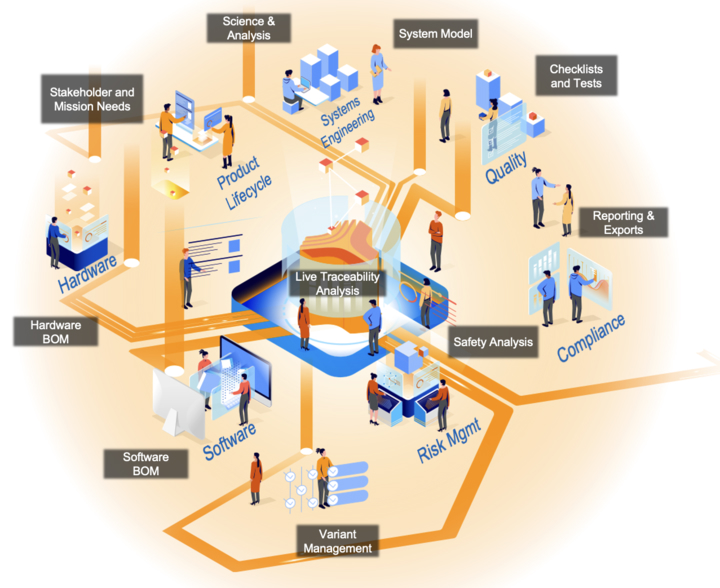This post was originally published December 18, 2020, and has been recently updated.
Digital Thread Defined
Digital Thread Definition – a data-driven architecture that links together information generated from across the product lifecycle and is envisioned to be the primary or authoritative data and communication platform for a company’s products at any instance of time.
This is the best definition of Digital Thread we are aware of and is from an excellent 2018 paper by Singh and Willcox at MIT entitled Engineering with a Digital Thread. The term Digital Thread was first used in the 2006 with the publication of the Global Horizons report from USAF Global Science and Technology Vision task force. (If you have an earlier reference please share in the comments). In this document, Digital Thread is defined as “the use of digital tools and representations for design, evaluation, and life cycle management.”
As with many business terms, Digital Thread has now become over-used by consultants and software vendors. The definition of it — and how it differs from Digital Twin — have been interspersed with more general concepts of integration, simulation, data, and analytics and has lost the original, more precise meaning.
Digital Thread Components
Let’s break down the definition of Digital Thread into its components to better understand the concept and share the most common approaches we see as companies move to make the Digital Thread a reality. Here is the definition breakdown:
1 – a data-driven architecture
This recognizes that the use of a single common platform is impossible across all engineering disciplines (software, hardware, electrical, systems, risk, QA, etc.). Instead, a data-driven approach is required that determines the key information required from multiple tools. It’s important to remember that data-driven does not mean “gather all your data” but rather that you should be using data to answer questions. In other words, do not fall into the trap of tool focus, but rather focus on the questions and collect data to provide the answer.
2 – that links together information generated from across the product lifecycle
From initial requirement definition through to product release, significant information is generated across multiple tools. The challenge is to identify what information is most relevant and how to best link the information to make it actionable. The most common link we see is the definition of value to be delivered (user and system requirements). The most typical information captured across the product lifecycle are process statuses and exceptions (e.g., requirements that have not been approved, require rework, or are not fully addressed, gaps in testing or risk analyses). By linking these process statuses to requirements and tracking them through the product lifecycle it is possible to reduce the risk of negative product outcomes (e.g., delays, defects, cost overruns).
3 – and is envisioned to be the primary or authoritative data and communication platform
Most companies refer to this as a “system of record” or a “single version of the truth.” A Digital Thread is much more than simply integration or a data lake. By tying the definition of what is to be delivered (requirements) to the most critical downstream process meta-data, a Digital Thread create the ability to understand the state of the product development process, what risks are visible and what corrective actions should be considered. Without a Digital Thread, a company is flying blind in terms of the risks it faces in product development.
4 – or a company’s products at any instance of time
For a Digital Thread to be truly useful it must always reflect the current state of the product development process. The value is in seeing the product development process for the first time across fragmented teams and tools, to be able to identify process exceptions and early indicators of potential downstream risks. A static database of days or weeks old data will not be sufficient for a process that is changing rapidly across multiple, siloed teams.
Why the Digital Thread is So Important
The product development process is often fragmented across siloed teams and tools which leads to significant risk of product delays, defects, cost overruns, failed verification and validation, recalls, etc. End-to-end process visibility is required for better cross-team collaboration and the early detection of anomalies to reduce these risks. To solve for this, organizations often attempt to force everyone to use one common software platform, forgoing their choice best-of-breed tools. This solution is neither practical — nor particularly realistic — since engineers are (and should continue to be) allowed to choose discipline-specific tooling which optimize their activities.
What is required is a loosely coupled approach that ties together the necessary metadata across these disparate tools in a way that connects the desired outcome (user and system requirements) to downstream activities – the Digital Thread. The Digital Thread is the best approach to reduce the risk of negative product outcomes while preserving engineering autonomy and productivity.
Click here to learn how Jama Connect’s Live Traceability™ enables a digital thread.


![[Webinar Recap] Transformative Airborne Systems Development [Webinar Recap] Transformative Airborne Systems Development](https://www.jamasoftware.com/media/2021/05/2021-05-27-Airborne-Systems-Webinar-Recap.png)
 Digital transformation is an urgent priority for businesses in 2021. Many organizations accelerated their
Digital transformation is an urgent priority for businesses in 2021. Many organizations accelerated their 